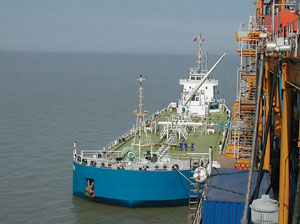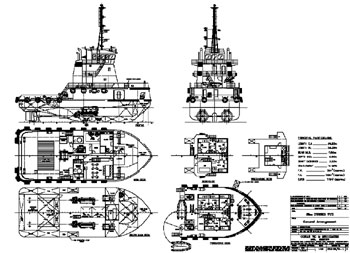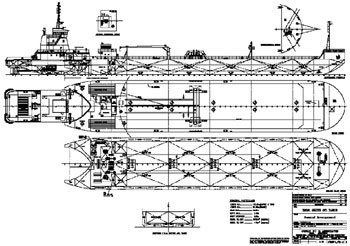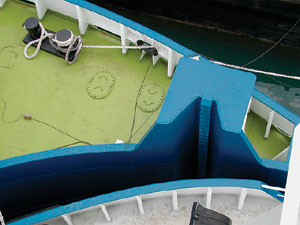Offshore Report
Articulated tug-barge (ATB) shuttle provides shallow water transportation
An effective, efficient solution handles crude shuttle transportation in the shallow waters of western Bohai Bay, China, for Apache/ PetroChina’s Zhaodong oil field.
Alan Wang, Kellogg Brown & Root, Inc., and Jianhua Yan and Shuyan Li, PetroChina
The Zhaodong oil field is located in the shallow near-shore waters of the western Bohai Bay, China, where water depths in the Zhaodong Block range from zero to 3.75 m. Initial development comprises two bridge-connected platforms, one drilling platform (ODA) with 60 slots, and one production platform (OPA) with 60,000-bbl crude oil storage. Oil produced at the ODA will be stored in the OPA and then periodically offloaded into the articulated tug-barge (ATB) shuttle vessel, which will moor directly adjacent to the OPA, Fig. 1. First oil started to flow at the end of July 2003.
 |
Fig. 1. ATB at the north side of the OPA Platform for crude loading.
|
|
Described here after the introduction are: ATB advantages, ATB design, basic features of the Articouple, and an overview of the ATB shuttle cycle.
Introduction. As part of the oil field development, Apache China Corp., field operator, contracted Bay Engineering to design the ATB shuttle system; Labroy Marine, the ship owner, to build the vessel in Batam, Indonesia; and Chimbusco to operate the shallow-draft ATB vessels between the offshore platforms and the Port of Tianjin in Tanggu, a 40-nautical mile trade route. The ATB vessels were designed for export of crude from Zhaodong to an offloading berth at the Port of Tianjin at up to 21,000 bbl per shipment. A narrow entrance channel and berth basins are used to access the OPA platform, where the channel is 2.7 nautical miles long and dredged up to 4.0 m.
The shallow-draft ATB incorporates use of a modern double-hull design, i.e., double side shells and double bottoms, required by IMO 1993, known as MARPOL ‘73/‘78. The hull has been suitably strengthened to withstand ice loading in the winter in Bohai Bay. Bow thrusters are adopted to provide good course-keeping capacity in the narrow dredged entrance channel and high maneuvering ability to berth at the OPA or Port of Tianjin without harbor tug assistance.
In the event of conditions severe enough to halt shuttle vessel operations, crude would accumulate in the storage tanks of the OPA. Should the tanks fill, production would be halted until the shuttle vessels could resume operations.
ATB advantages. In the early stage of Zhaodong Block development, the IPT evaluated both marine and pipeline transportation options. The marine option utilizes specifically-built shuttle tankers to transport the crude, while the pipeline option requires a total of 56 mi of pipelines and supporting onshore processing, storage and heating facilities.
The estimated CAPEX increase for the pipeline option severely impacts economics and likely makes project financing unobtainable for Apache and PetroChina, while estimated OPEX saving is not significant. The pipeline option would have delayed the project at least six months, and could have delayed first oil by one year or more. Thus the IPT concluded that project economics and schedule clearly indicated marine transportation was preferred.
Among the choice of shuttle vessels for the marine option, Apache, PetroChina, KBR, Worley, and Bay Engineering studied various forms of shuttle tankers and combinations of tugs and barges; and economic merits/ operation flexibility of tug/ barge units eventually prevailed.
Crude production rate will vary considerably over the 15-yr initial development. Production will ramp up quickly from 5,000 bpd after only 1-1/2 years. Then, production will drop off sharply to about 5,000 bpd after 10 years and 3,000 bpd at the end of the design life.
A single tug/ barge unit was proposed to be built to operate the first couple of years; a second barge could be added at a later date to satisfy the peak demand in a drop and swap operation. ATB is flexible, with capacity to match crude production by adding a second barge at about one-half the cost of a tanker and shorter building schedule. ATB tugs and barges are built as separate units, possibly reducing total construction time. Most important, the ATB manning requirement is just about half that of regular tankers, and even about a quarter of the manning requirement in the drop/ swap operations of one tug and two barges.
Of course ATB has its own setbacks. Compared with conventional tankers, it has inferior performance, including ship resistance, propulsion, seaworthiness, etc. In addition, the Articouple system which couples tug and barge together is very expensive.
ATB design. Early pusher-barge techniques are the rope-connected, river-service pushers first used in America and Europe, then introduced into Japan in 1964 for the bottom-dump barges used to build the manmade islands in Kobe Harbor. These early pusher-barge units could stand up to only one-meter high waves. Until 1972, the modern ATB vessels were developed respectively by E.H. Fletcher, known as the Artubar system in the US, and by T. Yamaguchi,1,2 known as the Articouple system in Japan.
Strictly speaking, ATBs are operated in dual modes, including pushing mode, which counts for most normal operations, and towing mode, only used in emergency cases. The pushing mode reduces total resistance of the combined unit and increases maneuverability, while the towing mode gives the ATB low manning requirement. Although the ATB Jin Tuo 10 Pusher Tug, Fig. 2, and Jin Bo 10 Crude Oil Barge, Fig. 3, is the first unit operated in Bohai Bay, there have been many ATB crude shuttle units operated in the US Great Lakes, East Coast and Gulf of Mexico.
 |
Fig. 2. General arrangement of 3,900-bhp Pusher Tug Jin Tuo 10.
|
|
 |
Fig. 3. General arrangement of 21,000-bbl Crude Oil Barge Jin Bo 10.
|
|
ATB vessels are designed to meet selected general specifications as follows:
- Ship type: Articulated tug-barge, shallow draft, ice strengthened, bottom reinforced, double-hull crude oil vessel.
- Class: A1 Oil Carrier (Double Hull), Coastal Service, Ice Class A0 with machinery notations AMS, SBT, or equivalent CCS.
- Cargo capacity: Capable of exporting maximum production from Zhaodong up to 20,000 bbl per shipment, a normal 95% barge capacity of 21,000 bbl.
- Maneuverability: Bow thrusters equipped to provide good course-keeping capacity in the narrow OPA channel and ability to berth at OPA or Terminal.
- Draft: Maximum draft, 3.2 m, tide-dependent to some degree, mainly due to wave-induced pitch and shallow-water squat at low tide. The bottom has been strengthened for seabed sitting/ impact.
- Water depth: 5 km, 72-m wide entrance channel has been dredged to 4.l0 m and equipped with navigation guides.
- Ice breaking: Capable of navigating in thickness of 30 cm, to 100% coverage.
- Operational sea states: Up to one-year return storm, with significant wave height of 3.38 m and one-hr mean wind of 54 mph.
- Cargo heating: Crude is maintained up to 60°C using thermal oil heaters.
- Loading/ unloading: Barge connects with hoses to load and discharge 20,000 bbl crude within 4 hr.
- Vessel power: The ATB supplies power required for cargo, diesel oil and ballast pumps winches/ windlass, bow thrusters, crane, lighting, navigation aids, and other vessel equipment.
- Accommodations: A crew of 12 persons plus two spares.
- Navigation: Radar, GPS system, lights and other navigation aids.
- Special requirements; 7.5 m x 9-m deck areas located at the stern are designed as deck stowage with a design load of 1,500 kg/m2; 3 m x 3-m deck areas located at the stern of the ATB tug were designed as deck stowage with a design load of 1,500 kg/m2.
Tug has these principal characteristics:
- Length overall: 28.0 m; depth at side, molded, 5.2 m; draft DWL, 3.2 m.
- Horsepower continuous: 3,900 bhp.
- Crew: 12; accommodations, 14.
- Lightship weight: 467 mt; displacement at DWL, 582 mt.
- Fuel capacity, 65.77 mt; fresh water, 21.84 mt.
Barge has these principal characteristics:
- Length overall, 97.2 m; beam molded, 18.0 m; depth at side, molded, 5.5 m; draft DWL, 3.2 m.
- Lightship weight: 1,600 mt; displacement at DWL, 4,775 mt; deadweight, 3,175 mt.
- Crude oil cargo @ 95%, 21,052 bbl; diesel oil cargo @ 95%, 446.2 m3.
Articouple system. ATB tug and barge are connected with couplers which comprise several types having different features, such as electrically driven Intercon systems, hydraulically driven Articouple-series and Triofix-series. In the push mode, the bow of the tug is in place in the notch of the barge stern secured with couplers to improve the seaworthiness and maneuverability of tug-barge units, Fig. 4.
 |
Fig. 4. Starboard vertical tooth-rake channel.
|
|
At the suggestion of J.P. Fisher,3,4 the ATB Jin Tuo 10 and Jin Bo 10 adopted the Articouple K-series of Taisei Engineering, developed by T. Yamaguchi, with a shallow notch. The Articoupler for a 2-point supported articulate connection is simpler and cheaper to fabricate, and the wave-excited load acting on the coupler is smaller than that of integrated tug-barge units. It permits free pitching of the pusher relative to the barge and, therefore, needs some wider clearance between their hulls to avoid hitting the tug’s stem against the wall of the stern notch of the barge.
This hydraulically operated articulate coupler provides an extremely reliable mechanical connection through engagement of steel teeth, which assures seaworthiness in rough sea. Articouple connection and disconnection can take place practically and in a short time by remote control from the bridge, even under the influence of waves. The components of wave load acting on the Articoupler are estimated for the sea state expected in Bohai.
Theoretical motion analysis is carried out for the coupler load analysis by solving numerically on a computer a series of simultaneous equations of motions by applying either the approximate 2D Strip Theory or the 3D Radiation/ Diffraction Theory with twin-body hydrodynamic interaction for the combination of tug and the barge.
The motion analysis was performed in Sea State 3 to obtain the amplitudes of longitudinal, transverse and vertical components of load, and the bending load on the side coupler pins as the resultant of longitudinal and vertical components calculated, taking into account their phases, in a wide range of wave period from 3 to 30 sec and in the full range of angle of encounter from head seas to following seas, thus determining their maxima.
Data obtained by the theoretical analysis generally agreed fairly well with the results of the tank experiments, and the differences between theoretical and experimental data are taken into account in the form of safety factor involved in the design of the coupler. In push mode, the bow of the tug is located inside the stern notch of the barge. The wide clearance between tug bow and barge stern causes heavy eddies. This will increase resistance and affect running speed. This is why speed of the tug-barge unit is lower than that of a conventional ship of the same loading and same engine power. Accommodations are located on the tug; and the oscillating tug due to heavy pitching can cause discomfort to the crew.
The clearance between hulls of barge and tug should be reduced to a minimum as long as a certain clearance is kept to permit free pitching of tug relative to barge. Also, the tug will have a full bow and a fine stern to streamline the flow running astern.
Use of propeller-nozzles is preferable in most cases in improving the propulsive efficiency. Further, nozzles are considered to decrease the vertical motions of stern when pitching in waves. This also has a favorable effect to rectify the flow into propellers under pitching, and prevent drop of speed to some extent. Although steerable nozzles are considered to assure a sufficient maneuverability in steering, the fixed Kort nozzles are not vulnerable to the grounding in the shallow-water area.
ATB shuttle cycle. A single tug-barge shuttle operation cycle was estimated based on design parameters such as ship speed, navigation distance, loading and unloading operations, berthing and unberthing operations, as well as harbor control regulations. The Tanggu Channel is strictly controlled by the Port Authority of Tianjin in a fashion that the ATB is only allowed to enter the channel at specific times for two hours and then exit the channel for the next two hours. Therefore the one-hour margin time is allocated for the waiting time to enter the channel and to exit the channel, respectively. Also, a delay factor of 85% was applied to the design values.
Summary. An articulated tug-barge system has been designed and built to provide an effective and efficient solution to crude shuttle transportation in the extremely shallow-water area of the western Bohai Bay, China, for the Apache/ PetroChina Zhaodong oil field. This 3,900-bhp pusher tug and 21,000-bbl oil barge were built in Batam, Indonesia, for the export service of crude oil stored in the OPA platform, to the storage tank farm located in the Port of Tianjin.
This shallow-draft, double-hull, bottom-strengthened, ice-class oil carrier was specifically purpose-built to deal with local environments and operation conditions, and be effectively and efficiently operated to meet the Zhaodong production demand and readily satisfy the future development with additional barges. 
ACKNOWLEDGMENT
Special thanks to Joseph Fischer, President of Bay Engineering; Toh Ho Tay, Shipbuilding Director of Labroy Marine; Neville Jones, Marine Manager of Apache Energy Australia; and Ronald Arceneaux, Onshore Operations Manager, Hugh Pryce, Project Director and Don Miller, General Manager, of Apache China Corp. for their valuable input and invaluable support.
LITERATURE CITED
1 Yamaguchi, T. “Means of connecting pusher boat and barge,” US Patent 3,844,245, assigned to Taisei Engineering Consultants, Inc., October 29, 1974.
2 Yamaguchi, T., “Twelve years’ experience with Articouple pusher-barge system,” 8th International Tug Convention, Singapore, 1984.
3 Fischer, J.P., “Design notes on Articulated tug/ barge connections,” GL&GR Section SNAME, October 29, 1999.
4 Fischer, J.P., “Design of an articulated tug & barge (ATB) to shuttle crude oil on the Bohai Gulf, China,” SNAME, 2003.
THE AUTHORS
|
 |
Alan M. Wang, lead naval architect for the Zhaodong Project, joined Kellog Brown & Root in 1998 and has over 12 years’ experience in design/ installation of offshore platforms and marine vessels. He earned a BS in naval architecture from Jiangsu University of Science & Technology; an MS in ocean engineering from the University of Hawaii at Manoa; a PhD in naval architecture and marine engineering; and an MSE in mechanical engineering from the University of Michigan.
|
|
 |
Jianhua Yan, Petrochina, project manager and JMC (Joint Management Committee) member of the Zhaodong Project, joined the company in 1983. He earned a BS in reservoir engineering from Petroleum University of China and an MBA from NanKai University. He is pursuing a PhD in geology from the Chinese Academy of Sciences.
|
|
 |
Shuyan Li, construction and operations coordinator for the Zhaodong Project, joined PetroChina in 1983, and has over 20 years’ experience in design and installation of oil/ gas treatment facilities. He graduated from China TV Education University and Tianjin Education College.
|
| |
|
|









